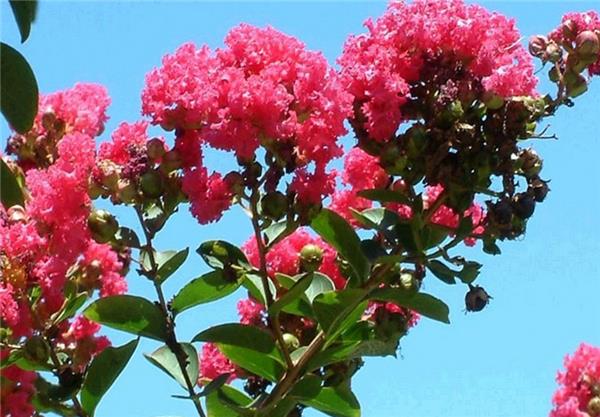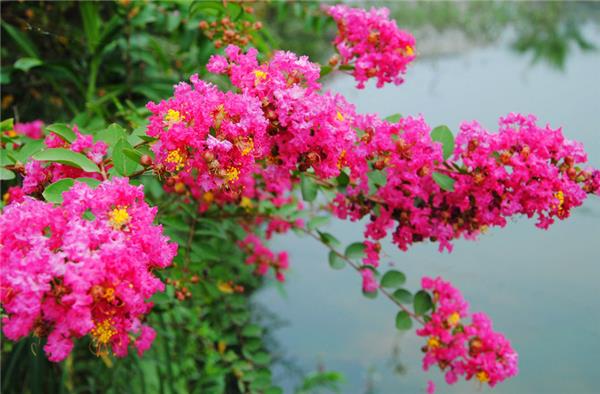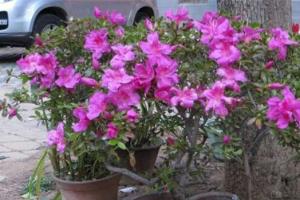Planting method of crape myrtle cultivation method of crape myrtle
Crape myrtle is one of our more common flowering plants, with bright colors and long flowering period. Many people choose to plant it in the courtyard at home. In addition, crape myrtle is also very good for clean air. Let's learn about the cultivation methods of crape myrtle.

1. Morphological characteristics
Crape myrtle belongs to the family Lycopodiaceae, which is commonly known as "ticklish tree". It is a peculiar tree species among trees. Crape myrtle is a flower and leaf tree, also known as skinless tree, full red, hundred days red. Due to the special flowering period, the flowers bloom continuously from July to October, so it is named hundred days Red. Yang Wanli, a poet of the Song Dynasty, wrote a poem praising: "it is better to be as crazy as drunk, and to be deceived by the wind." Who says there are no red flowers for a hundred days, and crape myrtle blossoms for half a year. " Xue Hui of the Ming Dynasty also wrote: "crape myrtle flower is the longest, rotten ten-day period, summer beyond the autumn sequence, new flowers continue to bloom." Northerners call crape myrtle tree "monkey thorn off", which means that the tree is too slippery for monkeys to climb up. Its value is that it has no bark.
Scarcity is precious. How many of the thousands of trees in the world are skinless? The young crape myrtle trunk, growing epidermis every year, falls off every year. After the epidermis falls off, the trunk looks fresh and smooth. Old crape myrtle tree, the tree body does not regenerate the epidermis, muscles and veins are exposed. Glossy and smooth. When the crape myrtle tree grows up, the bark of the trunk falls, smooth and skinless. If people gently touch it, they will immediately shake the leaves, tremble all over, and even make a faint "cackle" sound. This is its "ticklish" a systemic response, which is really amazing. There are 4 species of Lagerstroemia, including Chiwei, Yinwei, Cuiwei and so on. Cuiwei with blue petals is the best, as a panicle, bearing the top of new branches, up to 20 meters long, 6 petals per flower, petals multi-fold, like a disk. The flowers are full of trees and are as beautiful as Xia, so they are also called full house red. The result is a capsule, shaped like a soybean, with many seeds in it, maturing in November.

2. Cultivation methods of crape myrtle
1. Soil: crape myrtle has strong vitality, easy to cultivate and lax requirements on soil, but it grows best in deep and fertile sandy loam.
2. Fertilization: fertilizer can be applied every year after defoliation in winter and before sprouting in spring, such as human feces, urine or sesame sauce residue, which can make the plant grow vigorously and the flowers are big and colorful in the coming year.
3. Sunlight: sex is fond of light, lack of light not only has few flowers or no flowering, but also weakens growth and small branches and leaves.
4. Watering: crape myrtle is resistant to drought and afraid of waterlogging. it can be watered once a year before spring germination and after falling leaves in autumn. usually, if it is not too dry, it is not necessary to water it. Generally, it is necessary to water 1 Mel water three times during spring drought. In rainy season, it is necessary to do a good job of drainage to prevent big water from rotting roots. It is not suitable to water in autumn.
5. Pruning: crape myrtle inflorescence is born at the top of the new branch of the year, so it is necessary to re-cut and retract the annual branch when pruning, so that the nutrients are concentrated and the branches are strong, and the long branches, dry and withered branches, drooping branches, disease and insect branches, slender branches and endophytic branches should be cut off, and the lateral branches in the lower part of the plant trunk should be cut off in time in the young tree stage, so that the upper part of the trunk can get sufficient nutrients and form a good crown.
6, insect pests: crape myrtle common pests are velvet scale, yellow moth, big coir moth and so on, we should pay attention to pesticide control.
Crape myrtle is a good ornamental plant, which can be seen in home courtyards, parks and roadside green belts. The effect of beautifying the environment is very good. Those who like crape myrtle can choose to plant in the courtyard or potted plants for decoration. I hope the above knowledge can be helpful to you!
Related
- Wuhan Hospital Iron Tree Blooming Result Was Instantly Frightened by the Gardener Master
- Which variety of camellia is the most fragrant and best? Which one do you like best?
- What is the small blue coat, the breeding methods and matters needing attention of the succulent plant
- Dormancy time and maintenance management of succulent plants during dormancy
- Minas succulent how to raise, Minas succulent plant pictures
- What are the varieties of winter succulent plants
- How to raise succulent plants in twelve rolls? let's take a look at some experience of breeding twelve rolls.
- Attention should be paid to water control for succulent plants during dormant period (winter and summer)
- Watering experience of twelve rolls of succulent plants
- Techniques for fertilizing succulent plants. An article will let you know how to fertilize succulent plants.



